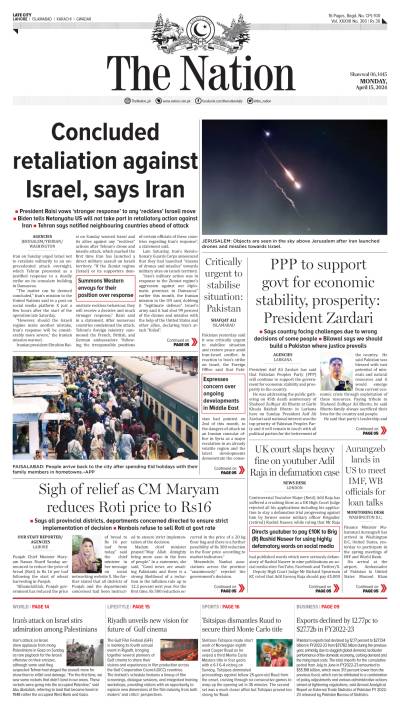ISLAMABAD - The ministry of finance has noted that Pakistan’s economic outlook has become uncertain and is likely to remain below the target in the current fiscal.
“The economic outlook for Pakistan in the current fiscal year has become uncertain and is likely to remain below the target. Macroeconomic imbalances may ease with the expected slowdown in the economic growth,” the ministry noted in its monthly, Economic Update & Outlook for September.
It observed that even if international commodity prices would mean-revert in the near future, domestic inflation may still suffer from delayed adjustments and second round effects. Also, the depreciation of the PKR continues to exert upward pressure on domestic prices. At the same time, according to the ministry, recent exceptional floods have destroyed human, physical, and livestock capital and deprived many families of their assets and incomes. Besides the cost in terms of lost lives and capital, these events will certainly affect the creation of gross value added and hence economic growth. The economy was already under pressure due to unstable economic conditions in the rest of the world and due to the necessary fiscal consolidation, high rates of interest, and inflation.
The ministry noted that budget deficit would widen, as the economy has been affected severely by widespread destruction brought by extreme flooding. “There will be a detrimental impact on the government’s fiscal situation from both the revenue and expenditure sides”. Budget deficit was recorded at 0.3 percent of GDP in July FY2023 against 0.4 percent last year. Whereas the primary balance posted a surplus of Rs 142 billion in July FY2023 against the deficit of Rs 5 billion last year. Net federal revenues in July FY2023 increased by 9.3 percent to Rs 229 billion against Rs 209 billion in the same period last year. Total expenditures increased by only 3.7 percent to reach Rs 536 billion in July FY2023 compared to Rs 517 billion in the same month last year. Within the total, current expenditures increased by 8.0 percent to Rs 531 billion in July FY2023 as compared to Rs 492 billion in the same period last year. For FY2023, the fiscal deficit is budgeted to reduce to 4.9 percent of GDP, while the primary balance is a surplus of Rs 153 billion.
Geopolitical conflicts continue to exist. Global and domestic uncertainties surround the economic prospects. High inflation, aggressive monetary tightening, and uncertainty from the Ukraine war and pandemic have hampered the global outlook in 2022. Soaring food and energy prices are eroding real earnings, generating a global cost-of-living catastrophe for vulnerable communities. The US, China, and the EU are slowing, which is affecting other countries. Rising government borrowing costs and capital outflows exacerbate fiscal and BOP pressures in many developing countries on the basis of forward looking indicators, further slowdown in global growth is expected. Therefore, Pakistan’s external environment faces rising challenges. Recent floods brought on by extremely strong monsoon rains have negatively impacted crops, altering the economic outlook mostly through agriculture performance.
Inflation has started reverting as the month on month (MoM) price increases have been on a declining path during the last two months. Though, the YoY inflation has shown significant acceleration from June till August. One reason is a steady decline in international food and oil prices during the last 2 months. On the other hand, since March, the Pakistani rupee is depreciating against the USD. One worrisome problem is the devastating effects of recent floods which have destroyed a substantial part of crops. However, their effects on inflation are being alleviated by prompt government measures to counter forms of price speculation and to provide sufficient supplies by allowing trade from neighboring countries. Still, the risk of second-round effects of recent inflationary shocks persists which may work themselves through the markets. It can also be observed that in recent years, the month of August shows a positive seasonality in the MoM inflation rate. All in all, September may show a halt to the recent drastic accelerations of the YoY inflation rate.
The agricultural outlook is still not clear as the output of both important and other Kharif crops has suffered significantly due to recent floods and unprecedented heavy monsoon rains. The stay of water in the cropping area may also affect the sowing of Rabi crops.
For the coming months, the baseline scenario is moderation in imports, following a domestic growth slowdown. At the same time, exports would stabilize, helped by a relatively stable REER at historically low levels. As a result, the trade balance could be expected to improve. Remittances are expected to stabilize at around current levels. This together with the expected path of the trade balance and other primary and secondary income transactions would guide the current account balance towards further improvement. But this scenario may be perturbed significantly by the consequences of the recent floods. These may limit export capacity and at the same time require more imports to satisfy the demand for products and harvests foregone.
Tuesday, April 16, 2024
Pakistan’s economic outlook uncertain: Finance ministry

Israeli Air Force finalizes preparations for possible attack on Iran
8:21 AM | April 16, 2024
Rising street crime alarms twin cities’ residents
April 16, 2024
Arrest made in deadly bus crash; owner still at large
April 16, 2024
Officials held responsible for patient’s drug denial
April 16, 2024
Police book 7 for torturing Christian family
April 16, 2024
Policing Reforms
April 15, 2024
Storm Safety
April 15, 2024
Deterrence Restored
April 15, 2024
IMF Challenges
April 14, 2024
Security Crisis
April 14, 2024
Suicide awareness
April 15, 2024
Biden’s dilemma
April 15, 2024
Over dependence on technology
April 14, 2024
Education reform call
April 14, 2024
Brain drain
April 14, 2024
ePaper - Nawaiwaqt
Advertisement
Nawaiwaqt Group | Copyright © 2024





